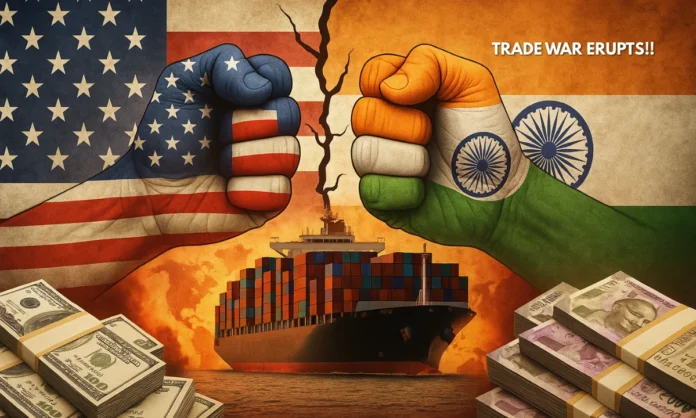Key Highlights:
- US-India trade crisis escalates with 50% tariffs on Indian exports announced in August 2025, shaking $59 billion worth of bilateral exchange
- BRICS emerges stronger and controls 39% of global GDP as an alternative for India’s redirected exports amid the US-India crisis
- Richard Wolff warns the US-India crisis will backfire on the West, accelerating BRICS integration and reducing reliance on Western markets
Opening Overview: Economic Confrontation Reshapes Global Trade
The US-India trade crisis represents a defining moment in global economic relations and power balances. Triggered by President Trump’s dramatic imposition of 50% tariffs on Indian exports, this US-India trade crisis now impacts more than $59 billion in goods and jobs, making headlines far beyond both nations. While the US aimed to penalize India for its energy relationship with Russia, economists warn that this US-India crisis is helping solidify BRICS as a world-leading bloc. With India now the most populous country, global trade flows are set to pivot, and the US-India crisis has hastened the rise of alternative trading frameworks.
#India has taken a tough stance against #Tradetariffs by the #USA. https://t.co/xmKas7WTU4
— Vaibhav Kalwadkar (@VaibhavHariom) August 29, 2025
Trump’s Tariff Strategy: Escalating the US-India Trade Crisis
- The US-India trade crisis worsened after Washington doubled tariffs from 25% to 50% on 66% of Indian exports on August 27, 2025
- Policy targets India’s ties to Russian energy, fueling diplomatic tensions and deepening the US-India trade crisis
The US-India crisis became unavoidable as the United States, in a bid to pressure India over Russian energy purchases, enacted the harshest tariff regime seen in years. Now, Indian sectors such as textiles, gems, chemicals, leather goods, and marine products are directly affected by the US-India crisis, threatening jobs and industry growth. While some high-impact sectors, including pharmaceutical exports and semiconductors, remain exempt, most Indian exporters face new barriers in the ongoing US-India crisis.
President Trump’s move has made the US-India trade crisis one of the chief drivers for international economic realignment. Exports previously destined for American consumers are now seeking new homes, intensifying competition elsewhere. As Wolff notes, the US-India trade crisis may well strengthen India’s resolve to pursue independent policy and forge new strategic alliances.
India’s Strategic Response: Navigating the US-India Trade Crisis
- India condemned the US-India trade crisis as “unfair and unjustified,” urging restraint and negotiation
- Despite the US-India trade crisis, New Delhi has focused on diplomatic engagement and economic diversification abroad
Responding to the US-India trade crisis, India maintained diplomatic poise, avoiding retaliatory tariffs while seeking long-term alternatives for affected exporters. Recognizing the risk to thousands of exporters, India called the US-India crisis irrational, yet refrained from immediate countermeasures. Instead, India has prioritized new partnerships with BRICS nations to mitigate losses from the US-India trade crisis.
Experts estimate that Indian exports to the US may shrink by up to 45% in the next fiscal year due to the US-India crisis. Still, Indian policymakers are leveraging domestic market growth and forging deeper connections across Asia, the Middle East, and Africa. The US-India crisis thus serves as a catalyst for a wider shift in global trade relationships.
BRICS: An Alternative Rising After the US-India Trade Crisis
- BRICS expansion in 2024 gives India broader access to markets, responding to fallout from the US-India crisis
- BRICS now claims 39% of global GDP and nearly half the world’s population, a strategic alternative during the US-India crisis
The US-India crisis has accelerated India’s economic shift toward the BRICS bloc. With the addition of Saudi Arabia, UAE, Egypt, Ethiopia, Indonesia, and Iran, BRICS became a powerhouse, especially relevant amidst the US-India crisis. BRICS GDP growth continues to outpace the global average, and the bloc now represents 39% of global output.
BRICS countries control major resources—oil, rare earth minerals, and consumer markets—making them critical trading partners for India during the US-India crisis. The bloc’s population, now 48.5% of world total, supports a tremendous consumer base, helping India redirect exports away from the US-India trade crisis. More importantly, BRICS is actively developing trade mechanisms independent of the US dollar, reducing vulnerability to future crises like the US-India crisis.
Global Economic Implications: Lessons from the US-India Trade Crisis
- The US-India crisis could trim India’s GDP growth by as much as 1%, but also drives deeper integration with BRICS
- The US-India crisis signals limits of unilateral tariff strategies as global economic governance becomes more multipolar
As the US-India trade crisis reshapes bilateral and global relations, new lessons emerge for policymakers and businesses everywhere. The reduction in India’s exports and GDP, while painful, is offset by rapid diversification and increased trade with BRICS partners. The US-India trade crisis thus highlights the necessity of flexible strategy in an interconnected world.
Significantly, as US-India crisis unfolds, American dominance as India’s largest trading partner comes into question. With $131.84 billion in two-way trade in FY 2024-25, both nations have much at stake. But, the US-India crisis forces a re-evaluation that will shape global commerce for years to come.
Closing Assessment: The Future Beyond the US-India Trade Crisis
The US-India trade crisis demonstrates how aggressive economic policies can have unintended, even counterproductive effects. By attempting to penalize India, the US-India crisis has invigorated BRICS integration, accelerated India’s economic diversification, and may ultimately hasten a new era of global multipolarity. Evidence suggests the US-India trade crisis will reshape not only trade volumes but the fundamental rules governing international markets.
India’s capacity to find alternative partners and mechanisms, even as the US-India trade crisis continues, signals the waning influence of traditional economic power structures. The US-India trade crisis thus marks a milestone in global development.


